
Straddles the Elbe River, Hamburg is the largest city across the EU which isn’t a capital, home to almost 2 million people. Up until 1871, when Germany was unified from a hodgepodge of smaller entities, Hamburg was a fully independent city-state, and as such, retained much of its distinct identity to date. While the city’s sheer uniqueness attracts throngs of visitors from all over the world, it also boasts a considerable number of hidden gems and alternative places, where one can experience Hamburg for what it really is.
Often dubbed as “Germany’s Gateway to the World”, the Port of Hamburg is by far the country’s largest harbor as well as the third largest one in Europe, only behind Antwerp and Rotterdam. Whilst the port was built in the late 12th century, it wasn’t until the 1900’s when it really became the gargantuan commercial center it is today. Nestled along the Elbe River, the port is 110 kilometers upstream from the river estuary, officially making it a seaport.
By the turn of the 20th century, when the ship traffic from and to the port skyrocketed, there was a dire need for a brand-new pilot station, whereby maritime pilots will facilitate the entry and navigation of large incoming vessels across the narrow waterways. Constructed in 1914 on the tip of a small verdant sandspit, the Seemannshöft Pilot House has been providing pilotage services ever since, including radar monitoring, the measurement of wind speed, water level and temperature as well as hosting several pilot ships.
In spite of its utter functionality, the station was beautifully design to greet vessels, mariners and passengers as they enter the city of Hamburg. Since the masonry building underwent a series of alterations and additions over the years, it features a patchwork of styles and materials. Its most iconic part though is undoubtedly the 28-meter-tall signal and observation tower, whose two main façades are decorated with a large-scale golden clock.
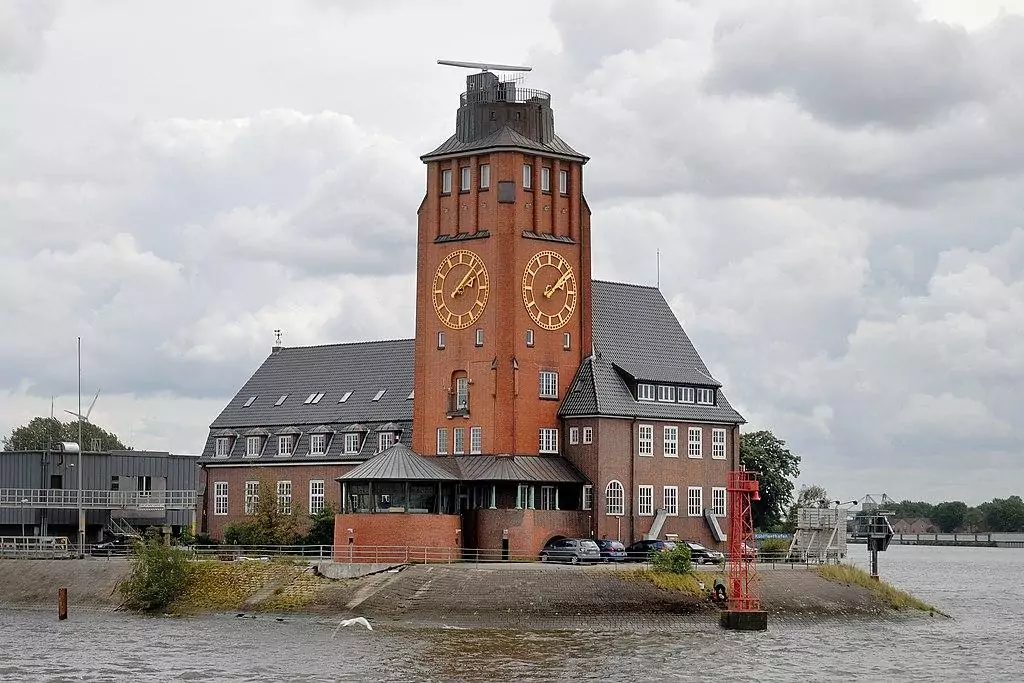
Seemannshöft Pilot Station and its pair of golden clocks
photography by: Peter Haas/ Wikimedia Commons
Whoever passes along Schulterblatt Street in Sternschanze district would find it impossible to ignore the insanely graffitied building of Rote Flora. Established in 1888 as a theater for operettas and concerts, Rote Flora was originally home to a ballroom, a concert hall and a Viennese-style café. However, its days of glory were short lived as it was forced to close down after World War I. In the years that followed the building served as a cigarette factory, a boxing ring, a bunker and even a housewares discounter.
In 1987, a well-known theater producer proposed to renovate Rote Flora and transform it into an upscale venue for musical performances. This move in turn sparked a massive wave of protests, carried out by a coalition of radical left-wing activists and local residents who feared that the plan would ultimately trigger a steep rise in rentals throughout the neighborhood. At one point, the former theater was squatted by a group of fervent activists who turned it into their base of operations.
The activists’ stubborn campaign finally bore fruits when the developers announce their decision to shelve the project, leaving Rote Flora to its own devices. As of today, the building remains an important hub for progressive ideologists, functioning as a cultural and political center where concerts, lectures and communal gatherings regularly take place. With a decrepit façade full of colorful murals alongside political graffiti and posters, the eye-catching edifice is simply too hard to miss if you happen to walk by.
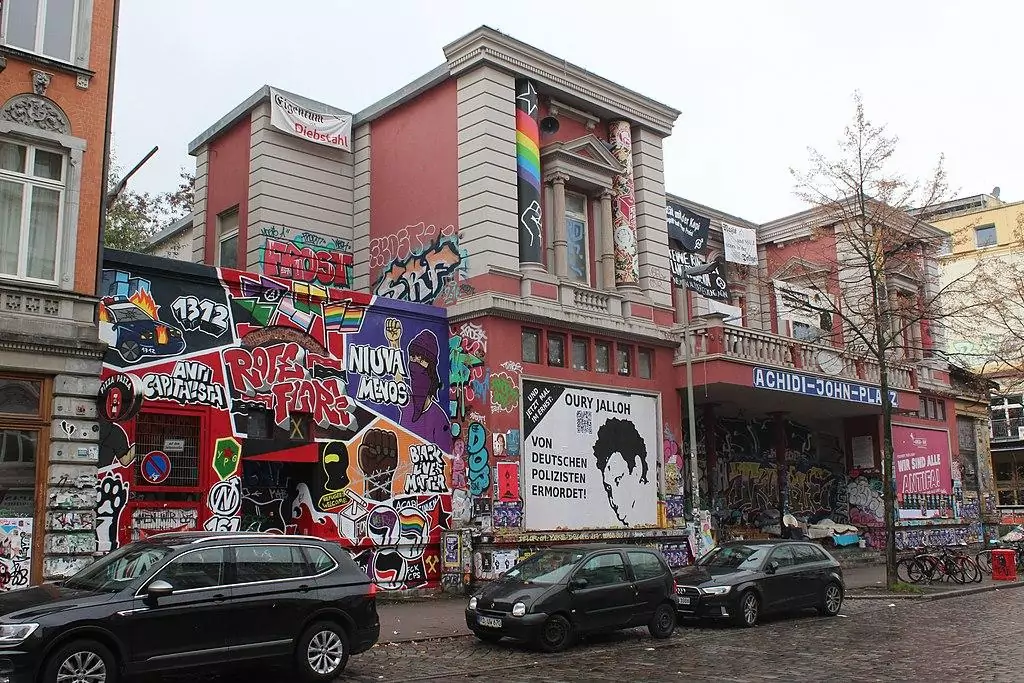
Rote Flora's main façade, chockfull of graffiti and murals
photography by: Hinnerk11/ Wikimedia Commons
Over two centuries ago, the area between Hamburg’s Berliner Tor station and the town of Bergedorf was entirely covered by sand, deposited by melting icebergs from the last ice age. However, due to Hamburg’s rapid urbanization process coupled with the use of sand in construction projects, only a fraction of it survived to these days.
Tucked away 10 kilometers east of Hamburg downtown area, the Boberger Dunes are the last remaining relic of the once ample sand formations. Designated as a nature reserve since 1991, the 350-hectare protected area is home to a quarry pond, a birch forest, a bog, tracts of geest and most importantly, a smattering of inland sandy dunes. This natural enclave also boasts numerous endangered species of plants and animals, including moor frogs, green woodpeckers, multiple rare butterflies and five types of orchids.
Visitors who wish to explore Boberger’s unique landscape can hike along the four trails that crisscross the reserve, one of which is a 6-kilometer-long loop that takes about 1.5 hour to complete. During summertime (particularly in august), Boberger is spectacularly carpeted with heather blossom as the surrounding grassland becomes awash with the purple flowers.
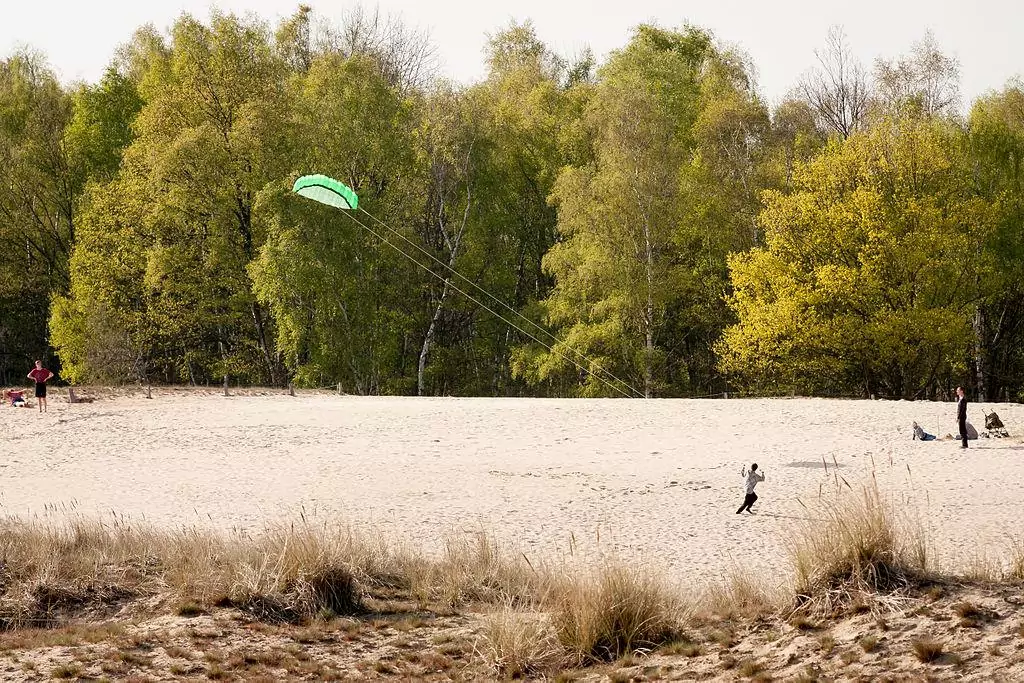
Boberger's sandy dunes on the backdrop of the close-by birch forest
photography by: Xaver Dolores/ Wikimedia Commons
During the Second World War, many cities across Germany fell into ruins after being targeted by the Allied air raids. As a countermeasure, the Nazi regime commissioned the construction of a series of flak towers in several German cities, including Hamburg.
Built in 1942 using a whopping 80,000 cubic meters of reinforced concrete, Flak Tower IV in Hamburg’s St. Pauli quarter served as an anti-aircraft bunker throughout the war. One of its main purposes was also to shoot down Allied warplanes, yet the latter dispersed strips of Aluminum foils which disrupted the radio waves, consequently neutralizing the tower’s four air defense batteries. In spite of the bunker’s echoing failure to intercept aircrafts, tens of thousands of local residents found refuge in its confines, spared from a certain death.
When the war ended, the 41-meter-tall concrete structure was repurposed a couple of times as demolition deemed unfeasible. Interestingly, the building’s 2-meter-thick walls that conferred it a total impenetrability in the midst of the war also made it the perfect location for loud nightclubs. As of today, the former bunker serves as a venue for electronic music performances while a popular club on its rooftop attracts partygoers from all over the region.
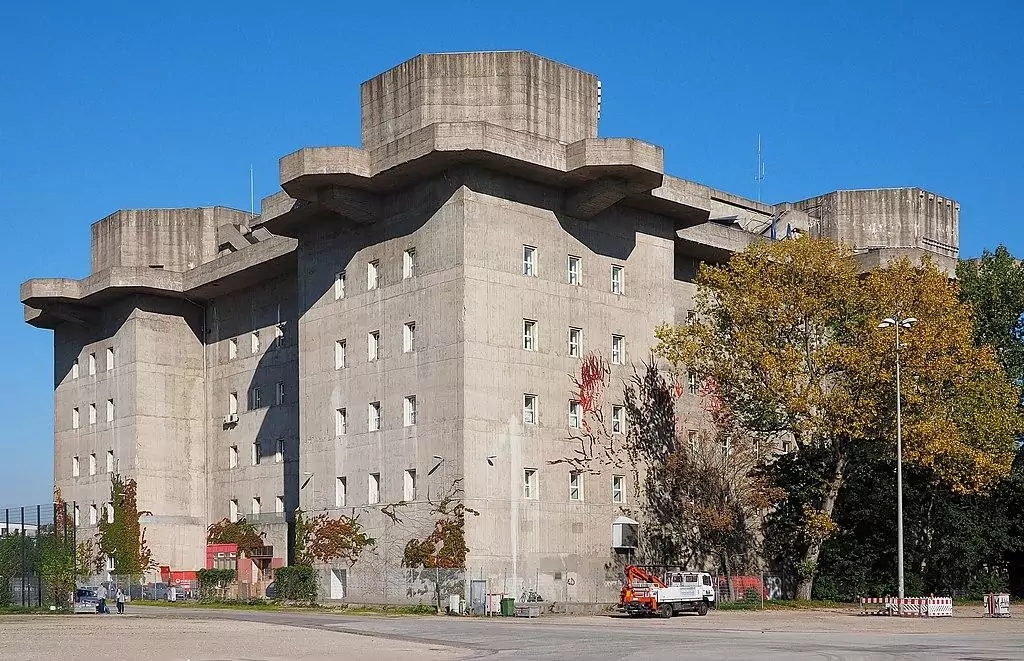
Flakturm IV, also known as Feldstraße Bunker
photography by: Nick-D/ Wikimedia Commons
The quarter of Neuallermöhe on the southeastern outskirts of Hamburg is a relatively new part of the city, and as such, is akin to a typical suburban neighborhood you’ll find anywhere around the world. Nevertheless, it turns out that even amid the seemingly uninspiring area one can find surprisingly interesting places.
Situated in front of Allermöhe train station, Fleetplatz is Neuallermöhe’s main square, abounds with a plethora of shops, restaurants and cafés. In the middle of this newly built plaza lies a massive sculpture, locally known as the Candy Cane Tower. As its name implies, the unusual monument was inspired by the popular candy, whose striped pattern was applied to the sculpture’s three poles, each of which provides a structural support for a 100-step spiral staircase.
Erected in 2004, the candy-shaped structure was designed by the local artists, Michael Dörner and Christoph Fischer, who sought to create a landmark for the nondescript neighborhood. The sculpture towers 25 meters over Fleetplatz, while its observation deck is 18 meter high. Despite of its modest height, climbing the tower is not for the faint hearted, as the ground below is clearly visible through its lattice staircases.
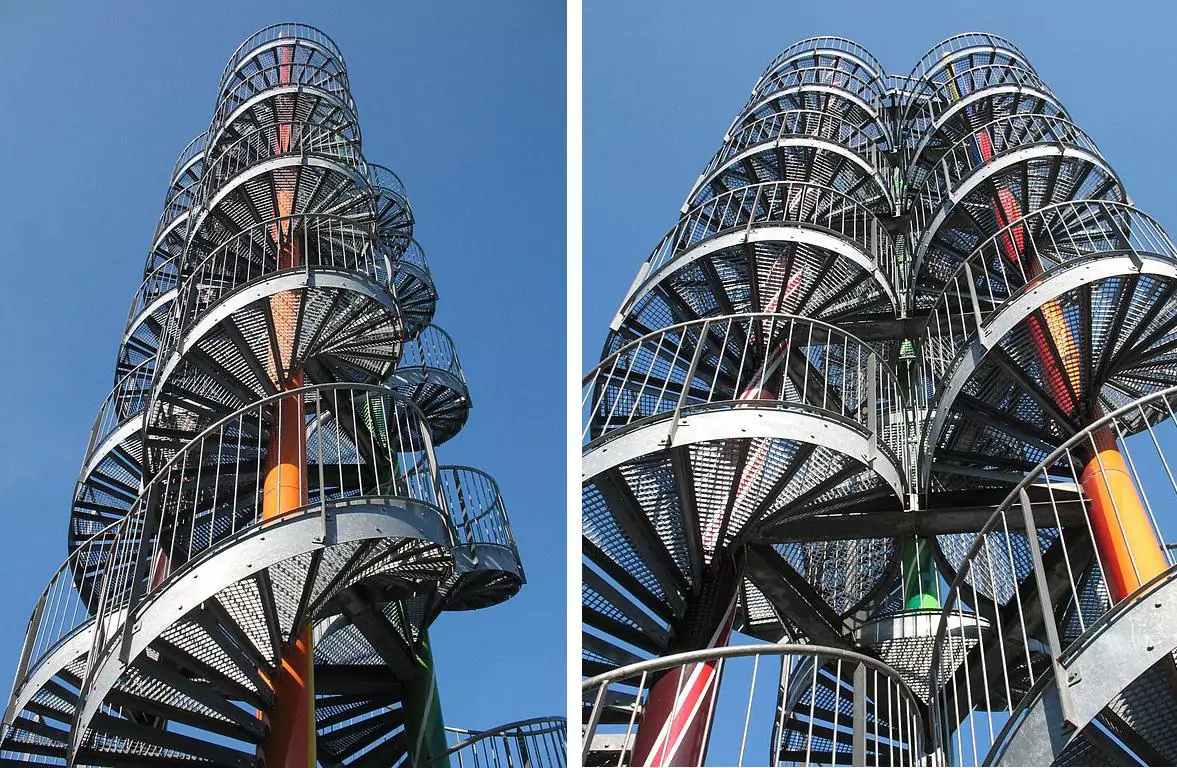
Neuallermöhe's candy cane tower, consisting of 3 spiral staircases
photography by: Doris Antony/ Wikimedia Commons
For almost a century, the iconic brick edifice in the district of Hammerbrook was home to the Reese & Wichmann chocolate factory which manufactured a wide selection of the coveted confection. Built in 1908 along the northern bank of the Südkanal, the factory was designed by architect Theodor Speckbötel who sprinkled the building with quaint ornaments as well as wide windows.
The industrial complex consisted of two wings centered around an inner courtyard. The wider west wing housed most of the machinery and the freshly produced chocolate, while the shorter east wing was where the packaging room operated. The boiler house and its ornate chimney were located slightly west of the main building. As the factory was nestled right next to a busy waterway, the bags of cocoa were transported directly to its own private jetty.
During World War II, the brick building was heavily damaged when the attic and gable were completely destroyed by the Allied air raids. Following a thorough renovation, the factory reopened its doors for a few more decades. As more and more industries began migrating to the suburbs, the factory was ultimately converted into an office and residential complex in 1997, while a glass roof and modern-style floors were added on top of the existing building.
It is true that the complex’s days of chocolate manufacturing are long gone, however, the building still manages to keep much of its original charm and character, and as such, is a worthy place to explore if you happen to be around. If you wish to complement your visit with a real chocolate experience, Hamburg’s chocolate museum offers insightful classes and tastings.
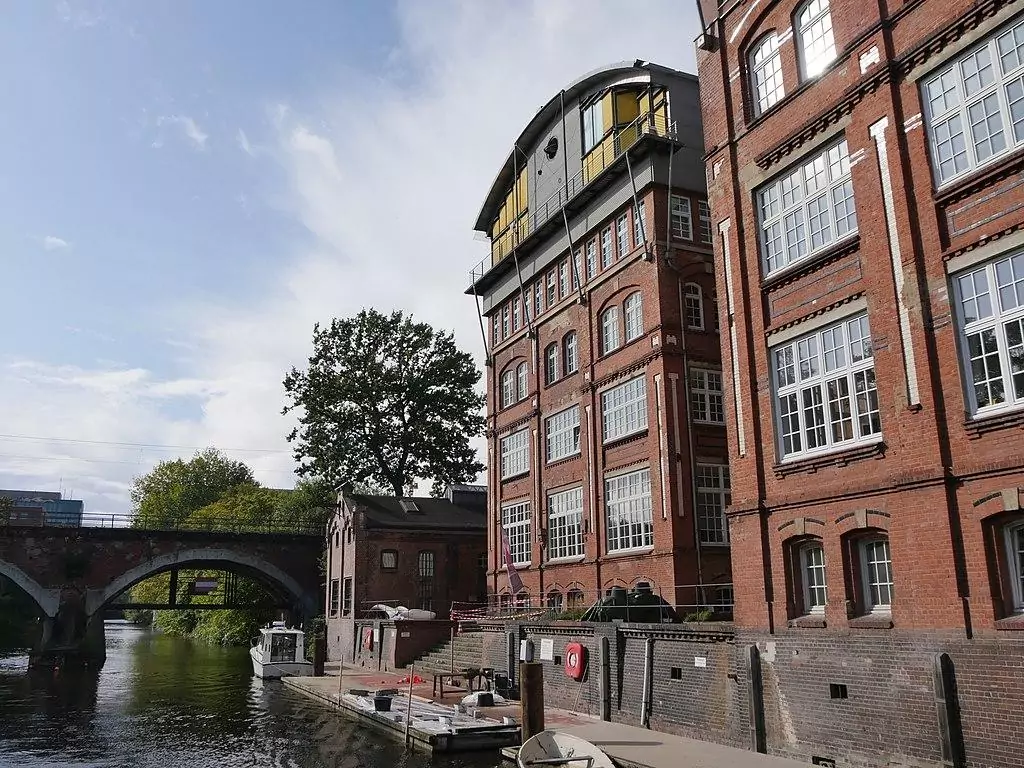
Nestled along the Südkanal waterway, Wendenstrasse Former Chocolate Factory
photography by: Reinhard Kraasch/ Wikimedia Commons
Often referred to as the Venice of the North, Hamburg is home to dozens of canals that run through the downtown area and beyond. The numerous waterways are in turn translated to a staggering number of roughly 2,500 bridges all over the city. Running parallel to the North Elbe River, Oberhafen Canal, Billhafen and Oberhafen are a series of interconnected waterways, forming together one of Hamburg’s largest canals in terms of width.
Marking the entrance to this cluster of waterways is Billhafen Löschplatz, an old discharge place for maritime vessels which is no longer operational for quite sometime now. At its heyday, the triangular platform was home to a couple of warehouses, all of which were demolished during the last decade.
Towering over the platform is the pier’s rusty old crane, the only surviving vestige of Billhafen’s bygone era. Listed as a municipal monument, this decrepit facility along with its surroundings recently became a canvas for graffiti artists who covered the dystopian landscape with vividly colorful murals. Beside the fascinating glimpse into the industrial heartland of Hamburg, the platform also serves as a lookout from where one can gaze at the nearby busy waterways and railway bridges.
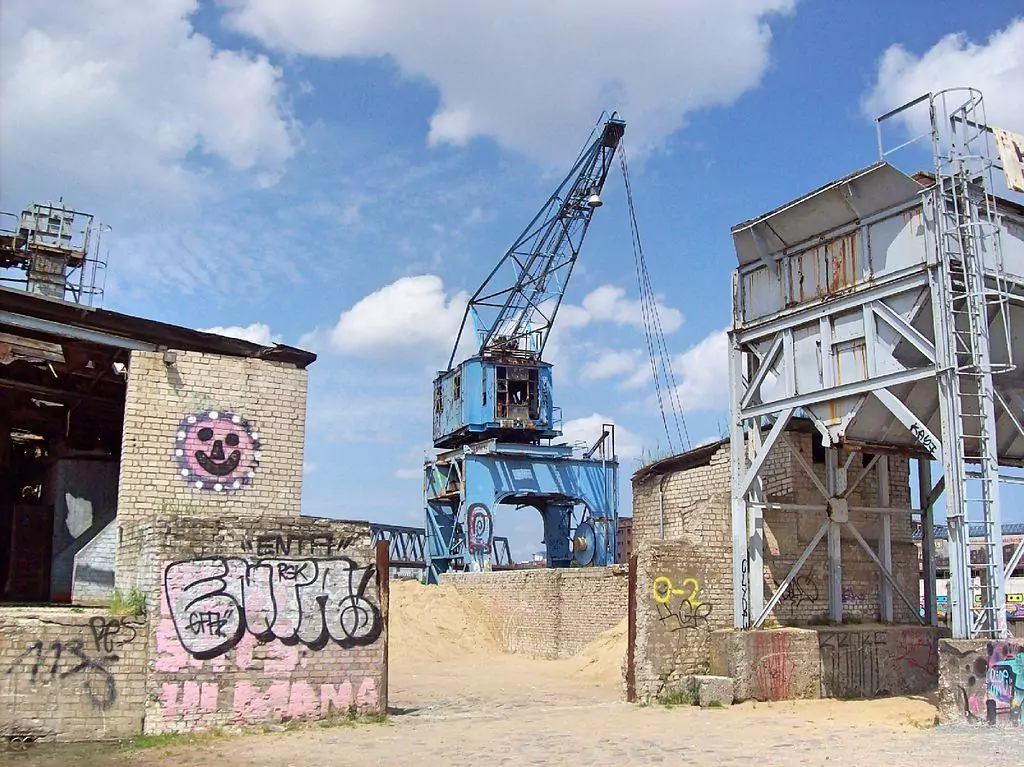
Billhafen's old crane, shortly before its surrounding buildings were demolished
photography by: Pauli-Pirat/ Wikimedia Commons
Stretching along the Elbe River’s northern bank, the 43-hectare Jenischpark is one of Hamburg’s most important green lungs, serving as a getaway for Hamburgers from all walks of life. This verdant sliver of land is home to a natural reserve, exotic species of plants and bewilderingly, a botanical rarity known locally as the Birke wächst aus Eiche.
This unusual pair of trees consists of a 100-year-old birch tree growing out of the trunk of a 300-year-old English oak tree. Due to its extremely tilted position, the elderly oak is supported by a metal structure, somewhat reminiscent of its human counterparts. No one is really sure exactly how this bizarre tree couple came into being, albeit one theory is that a birch seed was accidently dropped by a bird directly into the oak’s hollow trunk. Soon after, the seed germinated inside its host tree and uninterruptedly became a full-grown birch.